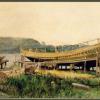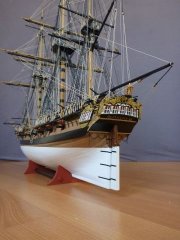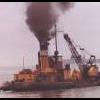-
Posts
483 -
Joined
-
Last visited
Reputation Activity
-
 ca.shipwright got a reaction from kier in Le Soleil Royal by EJ_L - FINISHED - Sergal - Scale 1:77 - 1669 Version
ca.shipwright got a reaction from kier in Le Soleil Royal by EJ_L - FINISHED - Sergal - Scale 1:77 - 1669 Version
E J
Looking good so far, sand and sand again.
Take a look at my posts under STORY STICKs. This may give you some added help.
Regards
-
 ca.shipwright got a reaction from EJ_L in La Couronne by yancovitch - FINISHED - RADIO
ca.shipwright got a reaction from EJ_L in La Couronne by yancovitch - FINISHED - RADIO
Just absolutely awesome!. I cannot wait to see a video of her under sail.
Regards
-
 ca.shipwright got a reaction from FrankWouts in SOLEIL ROYAL 1669 by michel saunier
ca.shipwright got a reaction from FrankWouts in SOLEIL ROYAL 1669 by michel saunier
Just when I thought the bar was at it's highest............
There just are no words................
Regards
-
 ca.shipwright got a reaction from Omega1234 in La Couronne by yancovitch - FINISHED - RADIO
ca.shipwright got a reaction from Omega1234 in La Couronne by yancovitch - FINISHED - RADIO
Just absolutely awesome!. I cannot wait to see a video of her under sail.
Regards
-
 ca.shipwright got a reaction from md1400cs in SOLEIL ROYAL 1669 by michel saunier
ca.shipwright got a reaction from md1400cs in SOLEIL ROYAL 1669 by michel saunier
Just when I thought the bar was at it's highest............
There just are no words................
Regards
-
 ca.shipwright got a reaction from Elijah in 18th Century Long Boat by alde - Model Shipways - Small
ca.shipwright got a reaction from Elijah in 18th Century Long Boat by alde - Model Shipways - Small
Very nice and clean beginning. Keep up the good work.
-
 ca.shipwright got a reaction from Overworked724 in Sultana by Overworked724 (Patrick) – FINISHED - Model Shipways – Scale 1:64 – Solid Hull – First Wooden Model Ship
ca.shipwright got a reaction from Overworked724 in Sultana by Overworked724 (Patrick) – FINISHED - Model Shipways – Scale 1:64 – Solid Hull – First Wooden Model Ship
Patrick,
Your model is coming along really well. The sculpy carvings are perfect. Keep up the great work.
Regards
-
 ca.shipwright got a reaction from Larry Cowden in HMS Victory by ca.shipwright - Panart Art 738 - 1:78
ca.shipwright got a reaction from Larry Cowden in HMS Victory by ca.shipwright - Panart Art 738 - 1:78
10/4/2017
Finally completed the planking of the hull. Completed the lower wale anchor stocking. Installed the diminishing plank and blended the plank into the hull. Planked the stern area, bending the planks into the wing transom and stern post. Blended these planks into the hull as well. Ebonized the hull for an inch or so below the waterline using the India ink. Everything got another coat of wipe on poly. Did whatever ebonizing touch-up which was required.
Finally completed the planking of the hull. Completed the lower wale anchor stocking. Installed the diminishing plank and blended the plank into the hull. Planked the stern area, bending the planks into the wing transom and stern post. Blended these planks into the hull as well. Ebonized the hull for an inch or so below the waterline using the India ink. Everything got another coat of wipe on poly. Did whatever ebonizing touch-up which was required.
4 of the cannon have become detached. 2 of them have come out of the backing piece. They will glue back in easily. The other 2 came out attached to the backing piece. Luckily, I was able to get these out through the stern. These will not be able to be reinstalled ini the original manner. I am going to make a plug sized to the gun port, glue the cannon to the plug and glue the whole thing into the gun port. This should be OK since the gun port lid will hide most of the repair
Now it’s time to open the copper plates. I have been told that the Mantua kit is short a good amount of plates. I tried to make some plates using ¼ inch sticky backed copper tape using a ponce wheel. These don’t look anywhere as good as the Mantua plates. The alternative is to make a stamping jig that will stamp the nail head pattern and either cut the individual plates off the strip, or, lay strips of stamped plates. They also come out a little larger than the Mantua plate which is 6 x 15 mm ( a little short of the ¼ inch width). The Mantua plate also has the nail heads embossed on all 4 sides. This means you install them by butting them up against each other without overlapping. I tried this with a test set and it really works very easily using CA and just sliding them into place. We will see what we will see.
-
 ca.shipwright got a reaction from catopower in HMS Victory by ca.shipwright - Panart Art 738 - 1:78
ca.shipwright got a reaction from catopower in HMS Victory by ca.shipwright - Panart Art 738 - 1:78
10/4/2017
Finally completed the planking of the hull. Completed the lower wale anchor stocking. Installed the diminishing plank and blended the plank into the hull. Planked the stern area, bending the planks into the wing transom and stern post. Blended these planks into the hull as well. Ebonized the hull for an inch or so below the waterline using the India ink. Everything got another coat of wipe on poly. Did whatever ebonizing touch-up which was required.
Finally completed the planking of the hull. Completed the lower wale anchor stocking. Installed the diminishing plank and blended the plank into the hull. Planked the stern area, bending the planks into the wing transom and stern post. Blended these planks into the hull as well. Ebonized the hull for an inch or so below the waterline using the India ink. Everything got another coat of wipe on poly. Did whatever ebonizing touch-up which was required.
4 of the cannon have become detached. 2 of them have come out of the backing piece. They will glue back in easily. The other 2 came out attached to the backing piece. Luckily, I was able to get these out through the stern. These will not be able to be reinstalled ini the original manner. I am going to make a plug sized to the gun port, glue the cannon to the plug and glue the whole thing into the gun port. This should be OK since the gun port lid will hide most of the repair
Now it’s time to open the copper plates. I have been told that the Mantua kit is short a good amount of plates. I tried to make some plates using ¼ inch sticky backed copper tape using a ponce wheel. These don’t look anywhere as good as the Mantua plates. The alternative is to make a stamping jig that will stamp the nail head pattern and either cut the individual plates off the strip, or, lay strips of stamped plates. They also come out a little larger than the Mantua plate which is 6 x 15 mm ( a little short of the ¼ inch width). The Mantua plate also has the nail heads embossed on all 4 sides. This means you install them by butting them up against each other without overlapping. I tried this with a test set and it really works very easily using CA and just sliding them into place. We will see what we will see.
-
 ca.shipwright got a reaction from Overworked724 in HMS Victory by ca.shipwright - Panart Art 738 - 1:78
ca.shipwright got a reaction from Overworked724 in HMS Victory by ca.shipwright - Panart Art 738 - 1:78
I completed the first layer of planking in all four quadrants. Rough sanded the planning to knock off any high spots. Filled some gaps left from some overzealous trimming of a few planks with Wellbond and sanding dust.
I then filled the resulting low spots between the bulkheads carpenters wood filler. I used a playing card as a screed since it was wide enough to span the bulkhead, much like you do with hanging drywall. This worked really well because the card is flexible.
Now, we wait for the wood filler to harden, give it a final sanding or, redo if it is not right and then another sanding.
-
 ca.shipwright got a reaction from clearway in HMS Victory by ca.shipwright - Panart Art 738 - 1:78
ca.shipwright got a reaction from clearway in HMS Victory by ca.shipwright - Panart Art 738 - 1:78
10/4/2017
Finally completed the planking of the hull. Completed the lower wale anchor stocking. Installed the diminishing plank and blended the plank into the hull. Planked the stern area, bending the planks into the wing transom and stern post. Blended these planks into the hull as well. Ebonized the hull for an inch or so below the waterline using the India ink. Everything got another coat of wipe on poly. Did whatever ebonizing touch-up which was required.
Finally completed the planking of the hull. Completed the lower wale anchor stocking. Installed the diminishing plank and blended the plank into the hull. Planked the stern area, bending the planks into the wing transom and stern post. Blended these planks into the hull as well. Ebonized the hull for an inch or so below the waterline using the India ink. Everything got another coat of wipe on poly. Did whatever ebonizing touch-up which was required.
4 of the cannon have become detached. 2 of them have come out of the backing piece. They will glue back in easily. The other 2 came out attached to the backing piece. Luckily, I was able to get these out through the stern. These will not be able to be reinstalled ini the original manner. I am going to make a plug sized to the gun port, glue the cannon to the plug and glue the whole thing into the gun port. This should be OK since the gun port lid will hide most of the repair
Now it’s time to open the copper plates. I have been told that the Mantua kit is short a good amount of plates. I tried to make some plates using ¼ inch sticky backed copper tape using a ponce wheel. These don’t look anywhere as good as the Mantua plates. The alternative is to make a stamping jig that will stamp the nail head pattern and either cut the individual plates off the strip, or, lay strips of stamped plates. They also come out a little larger than the Mantua plate which is 6 x 15 mm ( a little short of the ¼ inch width). The Mantua plate also has the nail heads embossed on all 4 sides. This means you install them by butting them up against each other without overlapping. I tried this with a test set and it really works very easily using CA and just sliding them into place. We will see what we will see.
-
 ca.shipwright got a reaction from Elijah in Sultana by Overworked724 (Patrick) – FINISHED - Model Shipways – Scale 1:64 – Solid Hull – First Wooden Model Ship
ca.shipwright got a reaction from Elijah in Sultana by Overworked724 (Patrick) – FINISHED - Model Shipways – Scale 1:64 – Solid Hull – First Wooden Model Ship
Great idea for squaring the cogs with the Phillips head. Thanks for sharing
-
 ca.shipwright got a reaction from thibaultron in Sultana by Overworked724 (Patrick) – FINISHED - Model Shipways – Scale 1:64 – Solid Hull – First Wooden Model Ship
ca.shipwright got a reaction from thibaultron in Sultana by Overworked724 (Patrick) – FINISHED - Model Shipways – Scale 1:64 – Solid Hull – First Wooden Model Ship
Great idea for squaring the cogs with the Phillips head. Thanks for sharing
-
 ca.shipwright got a reaction from Overworked724 in Sultana by Overworked724 (Patrick) – FINISHED - Model Shipways – Scale 1:64 – Solid Hull – First Wooden Model Ship
ca.shipwright got a reaction from Overworked724 in Sultana by Overworked724 (Patrick) – FINISHED - Model Shipways – Scale 1:64 – Solid Hull – First Wooden Model Ship
Great idea for squaring the cogs with the Phillips head. Thanks for sharing
-
 ca.shipwright got a reaction from Elijah in Sultana by Overworked724 (Patrick) – FINISHED - Model Shipways – Scale 1:64 – Solid Hull – First Wooden Model Ship
ca.shipwright got a reaction from Elijah in Sultana by Overworked724 (Patrick) – FINISHED - Model Shipways – Scale 1:64 – Solid Hull – First Wooden Model Ship
OW,
Just a little nit pick.
Look at photo 1 of wales at the transom. Port end grain is parallel to the transom. Stbd is angled. The same is shown in photos 2-4. You may want to correct this if this is not to due camera distortion.
Coming along very nicely. I'll get back to my Sultana one of these days. My Victory really has me hooked right now.
Regards
-
 ca.shipwright got a reaction from balsadustmaker in HMS Victory by Rich.F - FINISHED - Caldercraft - Scale: 1/72
ca.shipwright got a reaction from balsadustmaker in HMS Victory by Rich.F - FINISHED - Caldercraft - Scale: 1/72
You are so fortunate to live close by HMS Victory and be able to visit any time you want. I was fortunate to spend 2 full days touring the ship with 2 friends and a private guide. I experienced my most important historical moment while standing on the quarterdeck. I suddenly realized that Victory was older than my country. What a treasure she is.
-
 ca.shipwright got a reaction from thibaultron in Sultana by Overworked724 (Patrick) – FINISHED - Model Shipways – Scale 1:64 – Solid Hull – First Wooden Model Ship
ca.shipwright got a reaction from thibaultron in Sultana by Overworked724 (Patrick) – FINISHED - Model Shipways – Scale 1:64 – Solid Hull – First Wooden Model Ship
OW,
Just a little nit pick.
Look at photo 1 of wales at the transom. Port end grain is parallel to the transom. Stbd is angled. The same is shown in photos 2-4. You may want to correct this if this is not to due camera distortion.
Coming along very nicely. I'll get back to my Sultana one of these days. My Victory really has me hooked right now.
Regards
-
 ca.shipwright got a reaction from Elijah in Sultana by Overworked724 (Patrick) – FINISHED - Model Shipways – Scale 1:64 – Solid Hull – First Wooden Model Ship
ca.shipwright got a reaction from Elijah in Sultana by Overworked724 (Patrick) – FINISHED - Model Shipways – Scale 1:64 – Solid Hull – First Wooden Model Ship
Literally; "out of the mouth of babes."
Beautiful work all the way through. Your deck planking is one of the neatest and crispest I have seen.
Regards
-
 ca.shipwright got a reaction from Canute in Thickness sander
ca.shipwright got a reaction from Canute in Thickness sander
Moxis,
Both machine will "thickness" a billet of wood. As the photo shows, the Proxxon, as are all thickness planers, are used for pieces that are thicker. As stated, it goes down to 1mm on a sled. The Byrnes' thickness sander has a adjustment increment of .002 inch. Since most of the final thicknessing is going to be of wood strips which are both thin and narrow, the thickness sander will do a much better job. Also there is no danger of snipe of the ends of the pieces due to the out-feed roller of the planer. (Snipe is a concave depression on the top surface of the end of the work piece. It is very difficult to eliminate.)
In summary, you can thickness both large and small billets with both machines. The sander will do a much better job on strip wood.
-
 ca.shipwright got a reaction from Dan Vadas in Thickness sander
ca.shipwright got a reaction from Dan Vadas in Thickness sander
I have been using Jim's sander for about 12 years or so. Here are some observations:
- Each mark on the adjustment wheel is .002 in. Use a micrometer and measure more than one place on the strip.
- I use one course and one fine grit on the sanding drum. Sand close to finished thickness with the course paper and sneak up on finished thickness with the fine paper. (I just got the 6 inch hold down bar from Jim and use that with 6 inch paper to mill billets wider than 3 inches.)
- +/- .005 in is good enough for almost all applications. You won't see the difference and you will save a lot of wood.
- Turn the strip over with each pass. This will help to relieve internal stresses and prevent bowing.
- Be careful with boxwood. It's edge will cut you like a razor blade if it slides through your fingers. Don't ask.
- Save all your errors. You will always need a thinner piece somewhere down the line. This goes for the saw as well. You will always need a narrower piece somewhere down the line.
- Try and estimate how much of each size you will need and mill it all (+ 10%) in one set-up. Makes for good consistency.
- USE A DUST COLLECTION SYSTEM OR WEAR A RESPIRATOR. Wood dust can be very toxic.
- Mill ebony outside. You will never get ebony dust out of you shop or off the machine and ebony is toxic.
Hope this helps
-
 ca.shipwright got a reaction from mtaylor in Thickness sander
ca.shipwright got a reaction from mtaylor in Thickness sander
Moxis,
Both machine will "thickness" a billet of wood. As the photo shows, the Proxxon, as are all thickness planers, are used for pieces that are thicker. As stated, it goes down to 1mm on a sled. The Byrnes' thickness sander has a adjustment increment of .002 inch. Since most of the final thicknessing is going to be of wood strips which are both thin and narrow, the thickness sander will do a much better job. Also there is no danger of snipe of the ends of the pieces due to the out-feed roller of the planer. (Snipe is a concave depression on the top surface of the end of the work piece. It is very difficult to eliminate.)
In summary, you can thickness both large and small billets with both machines. The sander will do a much better job on strip wood.
-
 ca.shipwright got a reaction from mtaylor in Thickness sander
ca.shipwright got a reaction from mtaylor in Thickness sander
By flipping, I mean the surfaces that are being sanded. Also, try to identify the grain direction and always sand with the grain. This will help to prevent gouging or catching the sanding paper in the wood and tearing the paper on the drum.
-
 ca.shipwright got a reaction from Canute in Thickness sander
ca.shipwright got a reaction from Canute in Thickness sander
By flipping, I mean the surfaces that are being sanded. Also, try to identify the grain direction and always sand with the grain. This will help to prevent gouging or catching the sanding paper in the wood and tearing the paper on the drum.
-
 ca.shipwright got a reaction from PeteB in Thickness sander
ca.shipwright got a reaction from PeteB in Thickness sander
I have been using Jim's sander for about 12 years or so. Here are some observations:
- Each mark on the adjustment wheel is .002 in. Use a micrometer and measure more than one place on the strip.
- I use one course and one fine grit on the sanding drum. Sand close to finished thickness with the course paper and sneak up on finished thickness with the fine paper. (I just got the 6 inch hold down bar from Jim and use that with 6 inch paper to mill billets wider than 3 inches.)
- +/- .005 in is good enough for almost all applications. You won't see the difference and you will save a lot of wood.
- Turn the strip over with each pass. This will help to relieve internal stresses and prevent bowing.
- Be careful with boxwood. It's edge will cut you like a razor blade if it slides through your fingers. Don't ask.
- Save all your errors. You will always need a thinner piece somewhere down the line. This goes for the saw as well. You will always need a narrower piece somewhere down the line.
- Try and estimate how much of each size you will need and mill it all (+ 10%) in one set-up. Makes for good consistency.
- USE A DUST COLLECTION SYSTEM OR WEAR A RESPIRATOR. Wood dust can be very toxic.
- Mill ebony outside. You will never get ebony dust out of you shop or off the machine and ebony is toxic.
Hope this helps
-
 ca.shipwright got a reaction from Nirvana in Thickness sander
ca.shipwright got a reaction from Nirvana in Thickness sander
By flipping, I mean the surfaces that are being sanded. Also, try to identify the grain direction and always sand with the grain. This will help to prevent gouging or catching the sanding paper in the wood and tearing the paper on the drum.

















